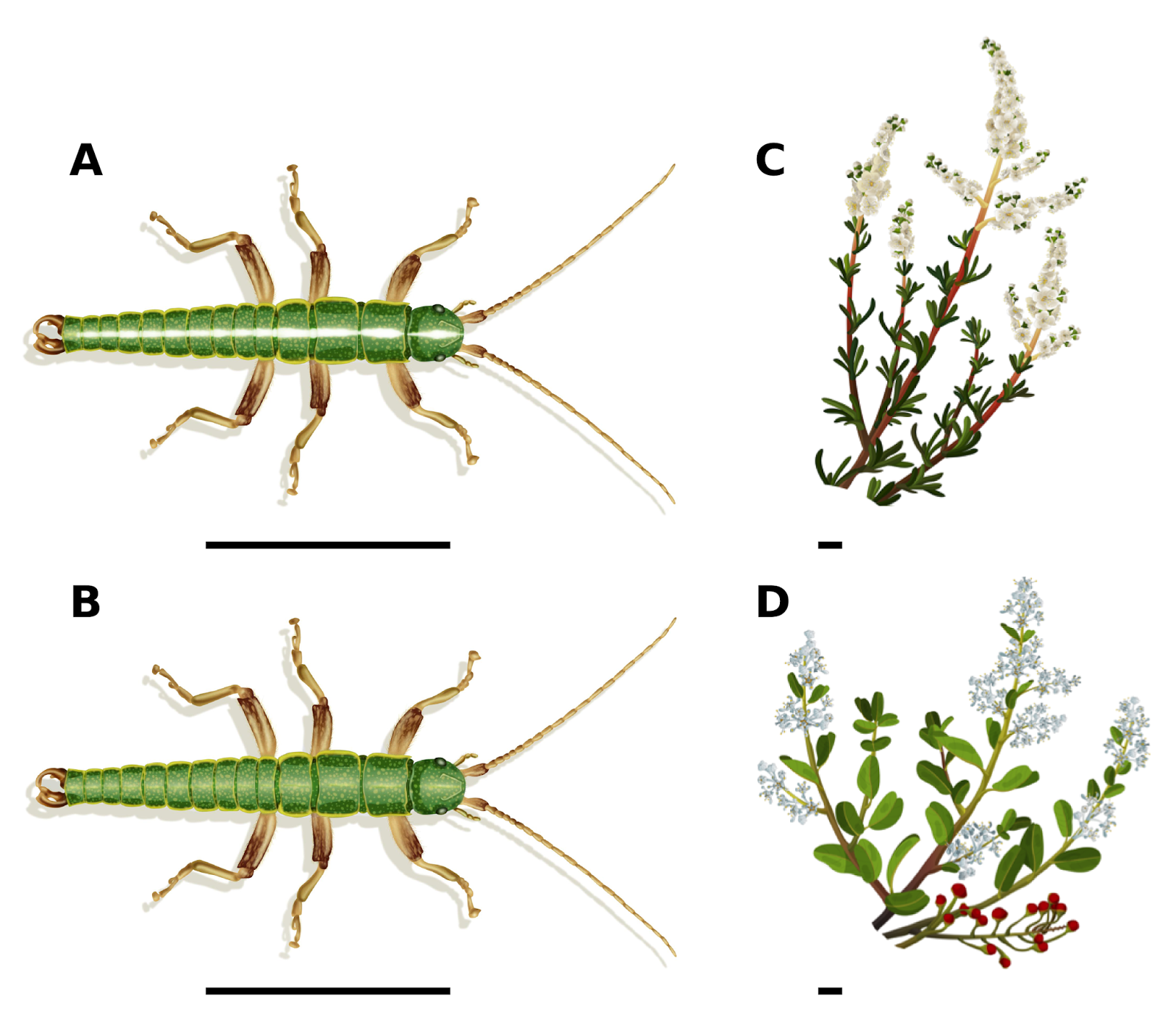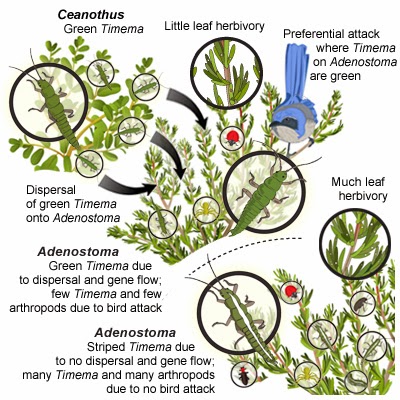Shortly after joining Patrik Nosil’s newly
formed lab at the University of Colorado, making it a busy research group of
two, I was coming to grips with the reality that I needed to gear up for a
serious transition from pure community ecology to hard-core evolutionary
genomics. This all turned around on a dime, however, after Andrew Hendry’s epic
visit to Boulder during the winter of 2009. Details are fuzzy, though I vaguely
recall a near-boiling hot tub, and too few beds at the end of a long night. Anyway,
despite scalded feet, Andrew’s visit ended with a changed direction for my PhD
and a new line of research for the Nosil Lab: eco-evolutionary dynamics!
Independent of my reorientation towards
the community ecology of eco-evolutionary dynamics, we were contacted by
Ilkka Hanski who, knowing Patrik’s work, was keen to use the stick insect Timema cristinae to evaluate one of his
recently developed mathematical models, which makes fine-scale predictions
about spatial patterns of local adaptation (Hanski et al. 2011). Timema cristinae experiences
strong divergent selection from birds for crypsis on its two dominant
host-plant species, Adenostoma
fasiculatum and Ceanothus spinosus, causing
the evolution of striped and unstriped morphs, each better camouflaged on Adenostoma and Ceanothus, respectively (see figure below, Nosil and Crespi 2006). However, the homogenizing effects of gene flow create complex
spatial patterns of local adaptation throughout the landscape (Bolnick and Nosil 2007), setting up an excellent scenario
to test Ilkka et al's model. It seemed as though Ilkka’s proposed research would
dovetail nicely with the ecological work we were planning to do in Timema come spring, so we began a
collaboration with him and his postdoc Tommi Mononen. This collaboration culminated
last month with a nice publication in Current Biology (Farkas et al. 2013).
(A) striped and (B) unstriped T. cristinae, (C) Adenostoma fasciculatum, (D) Ceanothus spinosus
Black bar indicates approximate 1 cm scale
Rewind to the spring of 2011, when Tommi,
Patrik, my labmate Aaron Comeault, and I shared a one-bedroom apartment in Santa
Barbara, in which Patrik insisted on sleeping directly in front of the only
bathroom, apparently to prevent mid-night toilet visits by the rest of us.
Led by Tommi, we trekked into the Santa Ynez National Forest and began to collect
data. Using steel fence stakes, flagging tape, string, and a tape measure, we
manually mapped (old-school) 186 host-plant patches of Adenostoma and Ceanothus inhabited
by Timema, and sampled the bushes by
whacking their branches with a stick, recording
the abundance of the two morphs on each bush. We also performed two field
experiments, one of them in 2012, manipulating the number of striped vs.
unstriped Timema on bushes of Adenostoma. After the fieldwork was
done, behind the scenes in Helsinki, Tommi and Ilkka scripted away the wee
hours of every morning, evaluating their model with our data, and generating new predictions for us to test.
From these studies, we found a very strong
influence of evolutionary dynamics in T.
cristinae on ecological patterns, both for T. cristinae populations themselves, entire cohabitating arthropod
communities, and interactions between herbivores and their host plants. In the
mapped metapopulation network of T.
cristinae, we found significantly lower local abundances in host-plant
patches harbouring populations with high proportions of the poorly camouflaged
morph (unstriped on Adenostoma and
striped on Ceanothus). Also, as it
turns out, the mathematical model performed quite well to predict the spatial
patterns of local adaptation in Timema,
and made some interesting predictions about patterns of patch occupancy and
modified evolutionary trajectories for the Timema.
These results were corroborated by our manipulative experiments, which showed
lower abundances on Adenostoma bushes
stocked with the unstriped morph. Furthermore, we found lower abundance and
species richness of cohabitating arthropods on those bushes, as well as lower
rates of herbivory from sap-feeders. These community-level results suggested that
when birds are attracted to and forage on populations of poorly camouflaged Timema, they opportunistically eat or
scare away other arthropods as well, reducing herbivory. Our second experiment
involved a bird-exclusion treatment, and supported this hypothesis.
Graphical summary of the empirical results.
The various authors of our paper differ a
bit in their opinions about what is most interesting about the study, but I will
point to three main things. Firstly, eco-evolutionary research, and much
ecological research in general I venture to claim, tends to use single types of
evidence. I think one of the major strengths of our study is that it combines
manipulative experiments with field observations and mathematical modelling:
our experiments strongly support the notion that camouflage evolution in T. cristinae causes differences
in ecological dynamics, and our observational data show that it correlates with naturally observable patterns. Second,
evolutionary ecologists have little sense for how important evolution may be in
driving ecological patterns relative to traditionally examined factors. In our observational
study, we show that poor camouflage accounts for approximately
7% of variation in population size, comparable in magnitude to the effects of
host-plant species (5%) and habitat patch size (14%). For T. cristinae populations, evolution is in this sense “important”.
Lastly, our study is among few to empirically examine the ecological effects of
evolutionary processes other than natural selection, since we also look at gene flow and founder effects. The consequence is that we
have evidence in our system for ongoing effects
of rapid evolutionary processes on ecology: year after year, natural selection
rapidly increases local adaptation, and gene flow breaks it down, allowing
eco-evolutionary effects to persist through time.
To bring it all
full circle, Andrew was asked to write a news dispatch by Current Biology (Hendry 2013) to highlight the work he set in motion over three
years ago. Thanks for everything Andrew!
Illustration credit: Rosa Marin Ribas
Bolnick DI, Nosil P (2007) Natural selection in population subject to
migration load. Evolution 61:2229–2243.
Farkas TE, Mononen T, Comeault AA, Hanski I, & Nosil P. (2013) Evolution of camouflage drives rapid ecological change in an insect community. Curr Biol
23:1835–1843.
Hanski I, Mononen T, Ovaskainen O (2011) Eco‐evolutionary
metapopulation dynamics and the spatial scale of adaptation. Am Nat 177:29–43.
Hendry A (2013) Eco-evolutionary dynamics: Community consequences of
(mal)adaptation. Curr Biol 23:R869–R871.
Nosil P, Crespi BJ (2006) Experimental evidence that predation
promotes divergence in adaptive radiation. Proc Natl Acad Sci USA 103:9090–9095.






No comments:
Post a Comment